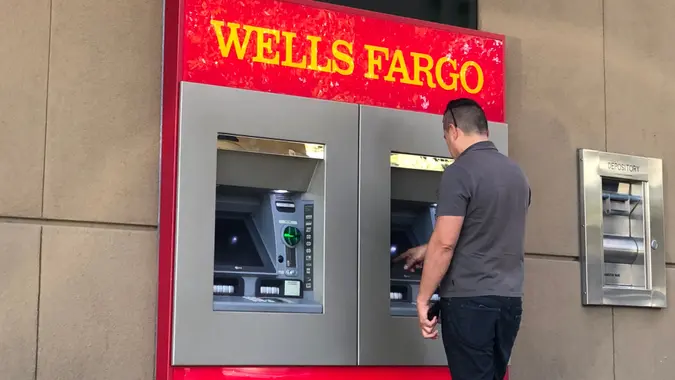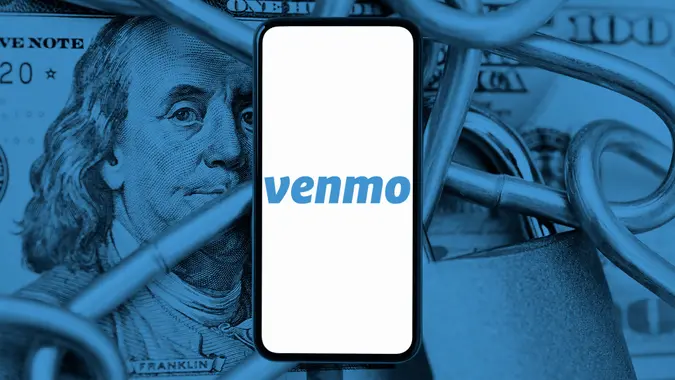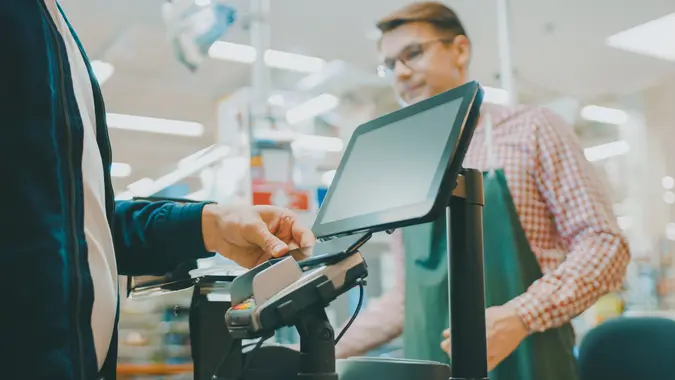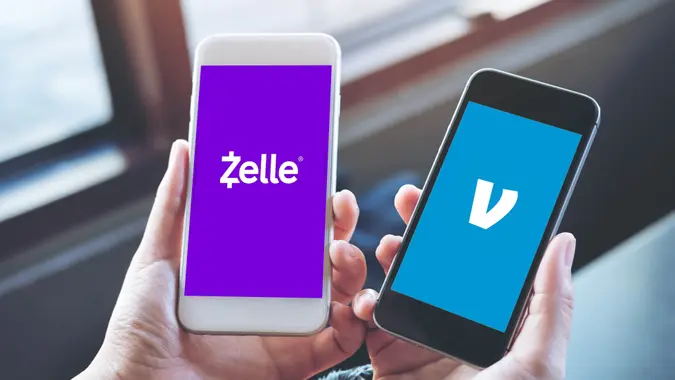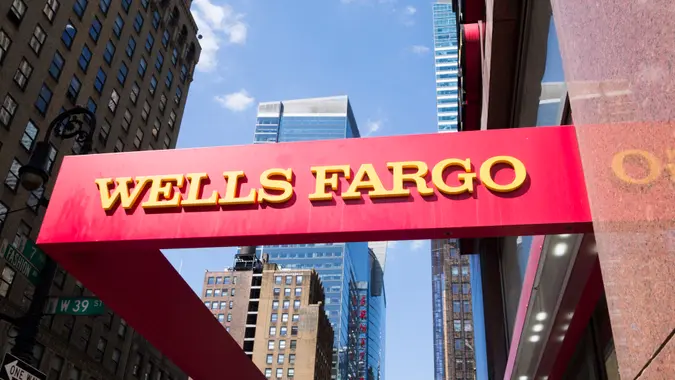What Is Venmo and How Does It Work?

Commitment to Our Readers
GOBankingRates' editorial team is committed to bringing you unbiased reviews and information. We use data-driven methodologies to evaluate financial products and services - our reviews and ratings are not influenced by advertisers. You can read more about our editorial guidelines and our products and services review methodology.

20 Years
Helping You Live Richer

Reviewed
by Experts

Trusted by
Millions of Readers
If you need to pay back your friend for grabbing lunch, or buy something from a local small business–you might want to use a peer-to-peer, or P2P, payment platform. Venmo is one of the most popular payment apps–with over 60 million users and billions in successful payments made each year. We’ll review how Venmo works, what features make Venmo popular, and what fees you might come across when using the Venmo app.
Read More: 3 Things You Must Do When Your Savings Reach $50,000
Quick Take: What Is Venmo?
Venmo was created by college roommates who wanted an easy way to send money to each other. Four years later, PayPal acquired the payment platform. With its simple foundation and PayPal’s innovative nature, it quickly became popular among users and widely accepted among merchants.
Here are some key takeaways:
- Venmo is a user-friendly peer-to-peer payment platform with a customizable social feed.
- Quick transfers are available through the Venmo app, Venmo credit card or Venmo Mastercard debit card.
- It offers similar capabilities as other money transfer platforms such as PayPal, Cash App or Zelle.
- If you are interested in a simple P2P system that does not charge astronomical fees, Venmo may fit the bill.
- Venmo is only available for people, banks, and cards located in the U.S. and typically requires an email address associated with your account.
- Venmo is only available as a mobile app–while you can view your transaction history online, you’ll need to download the app to send money or make payments with Venmo.
- Be aware that your spending and requesting money activity may be visible in the public Venmo feed. The news feed displays transactions you and your friends make while hiding the transaction amount. If you would rather keep your transaction history to yourself, you can change the settings to make all your transactions private.
How Does Venmo Work?
Venmo allows you to send payments to other Venmo users–or to make cashless purchases at businesses that accept Venmo payments. Venmo helps connect users that have different banks or payment methods–offering a single app that lets users transfer money seamlessly.
You can connect your debit card or a bank account to send payments to others. Venmo uses a custom username as an address for others to send or request payments from. You can also use the Venmo debit card to make purchases directly with your Venmo balance.
While Venmo was originally designed as a peer-to-peer payment app–many businesses now allow you to “Check out with Venmo” when making purchases. You can pay with Venmo at popular retailers like Uber Eats and GrubHub, and many small businesses offer Venmo at checkout online and in person.
How To Use Venmo
Venmo makes sending (and receiving) payments easy–here’s how to do it.
How To Send Money With Venmo
You can send some money from your linked bank account, credit card or debit card. If you have cash in your Venmo balance, that can be used, as well. To send money through Venmo, follow these steps:
- Select “Pay or Request” at the bottom of the app screen.
- Type in the person’s name, phone number, email or username. If they are not a Venmo user, they must first create an account.
- Type in the amount you wish to send. Add a note about what it is for, such as “shipping” or “service rendered.”
- Then, click “Pay.”
- The money will then appear in the recipient’s account.
Note: Before sending funds, make sure to check if your transaction will be listed as “Public” or “Private.” If you don’t wish to share the transaction publicly, you can change it to “Private” before completing the transfer.
How To Receive Money Through Venmo
When someone sends you money, it appears in your account balance. Venmo should notify you by email or phone notification, depending on your settings.
You can choose to keep the money in your Venmo account or transfer it to your bank or an eligible card. Since your Venmo balance can be used for shopping, transferring the funds isn’t always necessary. If you do decide to transfer, you have two options to do so.
Standard transfers. Standard transfers travel directly to your bank account via an ACH payment. They can take as many as three days to complete but often take less than that. These transfers cost absolutely nothing.
Instant transfers. If you need the money faster, you can choose an instant transfer to an eligible debit card. You will typically have your money in minutes. The fee for an instant transfer is 1.75% of the transfer amount or a minimum of $0.25. The maximum fee will not exceed $25.
How To Add Money To Venmo
Venmo allows you to hold funds within your Venmo account–which can be used for payments and transfers. To add money to your Venmo account, you’ll want to follow these steps:
- Within the Venmo app, go to the “Me” tab
- There is a button called “Add Money” that you’ll need to tap
- Choose a linked bank account or debit card to add money from
- Enter the amount you want to add to your Venmo balance
- Tap “Add”
Once your transfer to Venmo is initiated, you won’t be able to cancel the transaction. To get the funds back into your linked bank account, you’ll need to wait for the deposit to clear, and then initiate a transfer back to your bank. It may take a few business days for transfers to be added to your account. []
Venmo Features
Here are a few features that make Venmo stand out:
Splitting Bills and Expenses with Venmo
Venmo makes it simple to send money to friends or family members when you want to split the bill. For example; If you’re at a restaurant and you want to avoid the awkward “split the bill 7 ways” conversation with the wait staff–you can just use Venmo.
First, have someone pay for the entire bill in a single transaction. Then every other party can hop on Venmo and send the payer funds for their portion of the bill. This makes it easy to split up a bill at a gathering without doing complicated matches or making the restaurant try to split it up individually.
Using Venmo for Online Purchases
Venmo is available at checkout through many online retailers. Here are a few places you can use Venmo at checkout:
- CVS
- Forever 21
- Foot Locker
- Grubhub
- Lululemon
- Poshmark
- Uber Eats
- Urban Outfitters
In addition to popular online retailers, many small businesses offer Venmo at checkout as well. This means you can pay with your Venmo balance or linked account to make a purchase.
Venmo Debit Card
Venmo offers a Mastercard debit card through banking partner Bancorp–allowing you to make purchases using your Venmo balance with no additional fees. The Venmo debit card also offers rewards when you make purchases as select retailers online or in person.
The Venmo debit card can be used with mobile payment apps like Samsung Pay, Google Pay, and Apple Pay. Plus you get fee-free ATM access at 40,000 MoneyPass locations around the U.S.
Venmo Credit Card: Benefits and Rewards
Venmo also offers a traditional credit card through banking partner Synchrony. This rewards card offers 3% cash back in your top spending category, and 2% cash back in your second-highest spending category. All other spending earns 1% cash back on every purchase. The cashback is deposited into your Venmo balance and can be used for purchases. The Venmo credit card is a VISA card and can be used anywhere VISA cards are accepted. It can also be added to Apply Pay, Google Pay, and Samsung Pay accounts.
Venmo for Business
While Venmo is primarily designed for peer-to-peer payments, there are merchant services available for small businesses as well. Venmo allows you to set up and create a business profile for accepting payments. You can create a business profile as part of your main Venmo account–but this profile and account balance are completely separate from your personal Venmo balance. Payments can be accepted via direct payment, QR code, tap-to-pay, and online using Venmo on your checkout page. Venmo business accounts don’t have any setup or monthly fees–but charge 3.49% + $.49 per U.S. transaction. This is in line with other business merchant service fees.
Sending Limits
When you first create your Venmo account, you will go through a vetting process. To protect itself and its members, Venmo verififies your identity.
During this time, you will experience stricter sending limits, such as the following:
- $299.99 per week limit on purchases and payments
- No more than $999.99 per week in bank transfers.
Once you have been vetted, those limits increase to:
- $4,999.99 per week limit total on purchases and payments
- Up to $19,999.99 per week in bank transfers; only $2,999.99 at a time.
Venmo Fees
Venmo offers a budget-friendly option with minimal fees, which can often be avoided by adjusting your payment and transfer methods.
For instance, Venmo charges a 1.75% fee for choosing an instant transfer to your bank. You can avoid this fee by choosing a standard transfer. While it will take a little longer, it helps save some money.
Here’s a more detailed summary of Venmo’s fee schedule.
| Description | Fee |
| Opening account | $0 |
| Monthly or annual fees | $0 |
| Online purchases | $0 |
| Sending money from your Venmo balance, bank or debit card | $0 |
| Sending money to someone with a credit card | 3% of the transaction amount |
| Receiving money from a friend or a refund from a merchant | $0 |
| Transferring money to your bank account | $0, usually completes in 1 – 3 business days |
| Instant transfer to your debit card or bank account | 1.75% of transaction amount; $0.25 minimum up to $25, money is available in minutes |
Is Venmo Safe?
The short answer is yes. Venmo is a very safe P2P platform to use. It has encryption on par with banks and other financial institutions, and it was created to send money to people you know. When used as intended, it has little risk. Here are some factors to consider:
- The platform lets you add two-factor authentication. You can use a PIN code and fingerprint login to minimize the chance of someone else accessing your account.
- If you lose your phone, simply log into the website and update your settings.
- Venmo also has Fraud Protection for unauthorized transactions. You have up to 60 days from the date of a transaction to report it as fraud.
- It is important to note, though, that you are the best protection for your finances. Even the most secure platforms pose some risks.
- Always set up any available security precautions, such as two-factor authentication. Additionally, only send and receive money from people you know so you can reduce your risks.
One caution when using Venmo as your bank account is that your Venmo balance is not FDIC-insured. Should Venmo go out of business, you could lose access to your money with no insurance protection to cover the missing funds.
Venmo vs. Competitors
When shopping around for the best payment platform to fit your needs sometimes it helps to do some side-by-side comparisons of goods and services. Get ready to enter some pin codes as here’s a summary of how Venmo stacks up against some of its major competitors.
Venmo vs. Zelle
Zelle is a P2P feature in over a thousand banking apps. Users can send money to others whose bank is part of the network.
If your bank is not connected, you can still receive payments through Zelle and transfer your money to an eligible debit card. However, you typically have to wait longer for the transfer.
Zelle does not charge any fees. Your bank or debit card company may charge fees for using the service, though.
Venmo vs. PayPal
PayPal owns Venmo, so there are some similarities between the two platforms. One of the biggest is the target market. PayPal is useful to anyone, but it has added many products and services for businesses and professionals. Venmo is a simpler version of PayPal, created for people to easily send payments to people they know.
Final Take To GO
This peer-to-peer payment system is a great choice for individuals looking to send money to other individuals. Thanks to the addition of the Venmo debit card, it is now also an excellent choice for use at various merchants, as well.
FAQ
Here are the answers to some commonly asked questions about Venmo.- How does Venmo make money?
- Instead of charging users, Venmo makes most of its money from businesses that offer it as a payment option. Each time a customer makes a Tap to Pay purchase, Venmo charges a 2.9% transaction fee as well as $0.10 to the vendor.
- Do payments automatically get sent to my bank account?
- No. Any payments you receive will sit in your Venmo account until you initiate a transfer. You don't have to worry about your money moving without your knowledge or permission.
- Can I use Venmo for direct deposit?
- Yes, you can set up direct deposit easily. After your identity has been verified, go to the menu on your dashboard. Click "Settings" and then "Show Account Number." The screen will display your routing number and account number. Copy the information and use it to fill out your direct deposit form.
- Who owns Venmo?
- Venmo is owned by PayPal. It was previously owned by parent company Braintree—which PayPal purchased in 2013 for $800 million. [1]
- Can I have several Venmo accounts?
- In general, no, you cannot have two individual Venmo accounts. However, you can have a linked business Venmo account that is associated with your individual Venmo account. You can link a joint bank account to Venmo if you share a bank account or debit card with someone.
- Does Venmo report to the IRS for personal use?
- No, Venmo does not report your transactions to the IRS when they are marked as “Friends and Family.” The Venmo IRS reporting requirements are only for sales of items labeled as “Goods and Services” and are meant to stay compliant with the IRS for business transactions only. [1]
- Do you need a bank account for Venmo?
- While you don’t technically need a bank account to use Venmo, it would be expensive to only use a linked credit card for making payments (the fees are high). And while you can receive payments into your Venmo account, you’ll need a linked bank account if you ever want to cash out your Venmo balance.
Caitlyn Moorhead contributed to the reporting for this article.
Editorial Note: This content is not provided by any entity covered in this article. Any opinions, analyses, reviews, ratings or recommendations expressed in this article are those of the author alone and have not been reviewed, approved or otherwise endorsed by any entity named in this article.
 Written by
Written by  Edited by
Edited by 







